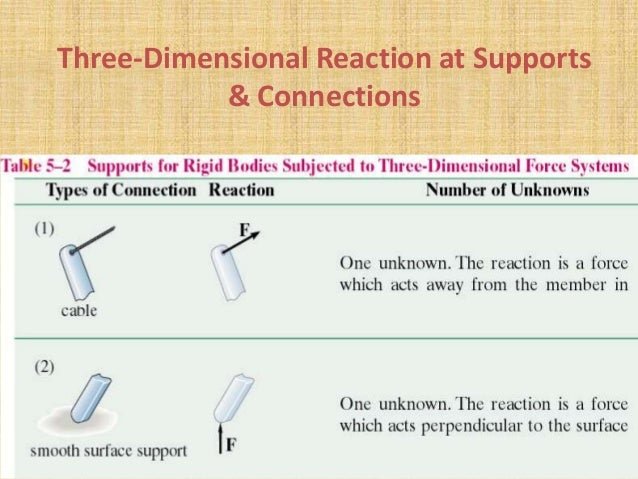
Source: ” Equilibrium Structures, Support Reactions, Determinacy and Stability of Beams and Frames” by LibreTexts is licensed under CC BY-NC-ND. In other words, the reaction force of a link is in the direction of the link, along its longitudinal axis.Ī fixed support offers a constraint against rotation in any direction, and it prevents movement in both horizontal and vertical directions.Įxample 2 (A x added even though it turns out to be 0): It permits movement in all direction, except in a direction parallel to its longitudinal axis, which passes through the two hinges. Its idealized form is depicted in Table 3.1.Ī link has two hinges, one at each end. The characteristics of a rocker support are like those of the roller support. The idealized representation of a roller and its reaction are also shown in Table 3.1.

It restrains the structure from movement in a vertical direction. Its idealized representation and reactions are shown in Table 3.1:Ī roller support allows rotation about any axis and translation (horizontal movement) in any direction parallel to the surface on which it rests. The following section provides a second explanation on reactions & supports:Ī pin support allows rotation about any axis but prevents movement in the horizontal and vertical directions. We don’t get into 3d problems in this statics course, needless to say, there are more reaction forces and moments involved in 3-dimentsions instead of 2 dimensions. The information shown here is to model 2d situations. Typically reaction forces are either as follows: a pinned and a fixed reaction force together (1 reaction force + 2 reaction forces = 3 restraints) or a fixed beam (2 reaction forces and 1 moment = 3 restraints). Here is a summary showing what motion is allowed by that type of constraint: Note that this applies only to 2d restraints. The fixed beam restricts vertical translation, horizontal translation, and rotation, so there is a moment and two forces. The pinned restraint doesn’t allow horizontal or vertical movement, hence the two forces. The roller only keeps the object from moving vertically, so there is only 1 force. You put a force to show how the restraint restricts motion. Notice that the Fixed restraint is the most restrictive and the roller is the least restrictive.
#Equilibrium 3d statics free#
Pinned constraint and then its free body diagram shown:.Two reaction forces acting perpendicularly in the x and y directions.equilibrium of rigid bodies lecture notes: walt oler. There are 3 different kinds of constraints we will focus on in this course and they each have different reaction forces and moments: eighth edition chapter vector mechanics for engineers: statics ferdinand beer russell johnston, jr. Reaction forces and moments are how we model constraints on structures. So we can use the same terminology, it is a fixed constraint, preventing horizontal movement, vertical movement, and rotation. We call the skywalk a cantilever beam and turn the real world beam into a 2d model with constrains. You want to be sure that the skywalk is so the people on it are safe. We model these real world situations using forces and moments.For example, the grand canyon skywalk lets people walk out over the grand canyon. How much weight can the beam handle before it breaks away or falls ‘off’ the wall? It depends on the way it’s attached to the wall. Plugging that in elsewhere, I get that Fac = -694.2 N and that F = 393.9 N, which are both wrong according to the marker.Imagine a beam extending from the wall. I plugged this Fac equality into equation 2, to get Fad alone.

I then rearranged equation 1 to get Fac in terms of Fad. I have a complete solution, but apparently it's not the right answer according to the teacher assistant (I don't know what the right answer is).Īnd I get that vector Fab = (142.85i + 214.285j - 428.55k)Nįac = (-0.2308(Fac)i + 0.30769(Fac)j - 0.923076(Fac)k)N (where the Fac's on the right side of the equation represent the magnitude of the force *vector* Fac)įad = (-0.333(Fad)i - 0.666(Fad)j - 0.666(Fad)k)N


If cable AB is subjected to a tension of 500N, determine the tension in cables AC and AD and the vertical force F which the mast exerts along its axis on the collar at A.įor this assignment, I'm pretty sure the prof just wants us to consider sum of Fx, Fy and Fz, and to take no moments.


 0 kommentar(er)
0 kommentar(er)
